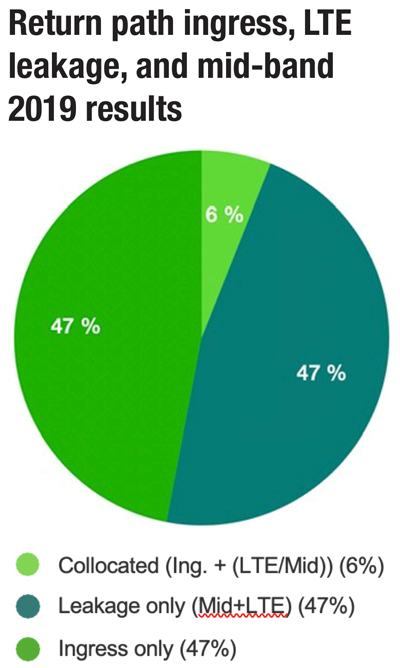Ingress Again?
By Ralph Ciarla
Making cable shielding effectiveness possible
Ingress, as far as the cable community is concerned, is the entrance into a cable system of any undesired external radio frequency source. Ingress can also be in the form of static or electrical noise. When connectors are installed improperly or left loose, or the cable is damaged, the signal that was meant to remain within the cable can leak out and cause interference. This is called egress. If the signal can leak out of the cable, outside interfering signals can also enter the cable. This is known as ingress.
For as long as we can remember ingress has been a major problem and discussion for cable operators from a cost and customer standpoint. Operators generally spend in excess of 75% of their OPEX budget addressing upstream ingress which is really finding and fixing compromised network shielding. This can occur in the home, drop, or outside plant but in all cases these shielding faults allow external interference to enter cable networks, disrupting services and/or allowing cable signals to leak out, potentially interfering with mobile or other over-the-air services.
Return path ingress is transient, and makes detection a constant struggle for cable operators. Therefore, current detection methods translate into tremendous technician time loss, compromised customer confidence and significant revenue loss.

The chart illustrates that the traditional leakage-only detection process fails to capture at least 47% of return path ingress impairments. The CPAT FLEX Ingress Detection Solution corrects this failure.
Balancing network reliability and ROI
With the rapidly growing demand for digital voice, data, and high bandwidth multimedia applications like OTT streaming, cable operators face major deployment challenges that can affect service delivery and network reliability.
Keeping pace with subscribers’ expectations while managing churn and OPEX forms a prime challenge for operators. Indeed, according to a study performed by CPAT FLEX on a two-way cable plant, (KPIs recorded: degraded cable modems, customer service calls, truck rolls) lack of network reliability is the single-most influential factor causing dissatisfaction in the cable television industry. Consequently, technical operation management and senior executives are continuously looking for solutions to decrease anomalies within their networks.
Return path ingress is a major source of network impairment, right next to LTE leakage and way before mid-band leakage. Therefore, maintaining a competitive edge in new broadband services will depend on cable operators’ ability to rapidly and effectively detect, locate, and overcome ingress within their networks.
Current detection methods rely on a process that takes from several hours to days to resolve. They are labor-intensive, time-consuming, and sometimes disruptive to subscribers. These methods lack the ingress detection and management tools that help cable operators maintain an efficient and reliable network. The results can translate into significant revenue losses – especially when it compromises customer confidence.
The individual tools that operators use to improve subscriber QoE by detecting, finding, and fixing service-impacting issues are steadily improving over time, but the effectiveness comes when synergies between them can be realized. Integration of PNM unlocks some value of these tools to find and fix ingress and harden networks against ingress issues. The question still remains how quickly we can detect, validate and repair the network shielding effectiveness.
Impairment distribution across ingress, mid-band, and LTE
The rules relative to cable leakage reporting compliance currently require operators to monitor leakage in the aeronautical band or mid-band. However, the benefits of monitoring additional frequency bands are huge, namely because of the widespread use of cellular occupying the 600/700 MHz band and the extended upstream spectrum of DOCSIS 3.1 (up to 204 MHz), which requires additional shielding integrity monitoring capabilities
Early in 2020, Effigis, now CPATFLEX evaluated the repartition of ingress and egress events. The compiled data covered all of 2019, from customers simultaneously monitoring ingress and egress. The accompanying graph demonstrated that together, mid-band and LTE leaks excluding ingress represented 47% of network events, while collocated ingress and leakage events accounted for 6% of all events.
Incorporating the ingress detection platform enabled the capture an additional 47% of events, thus increasing network reliability and decreasing customer downtime.
 Ralph Ciarla.
Ralph Ciarla.
Director Client Support & Marketing,
CPATFLEX Inc.
Ralph is an experienced global sales and marketing professional with a long history of working in the telecommunications industry. In his capacity of Director at CPATFLEX, he manages the internal and external sales, support functions, and marketing activities. He is also Associate Director with the SCTE Canadian Ontario Chapter.
Images provided by author



